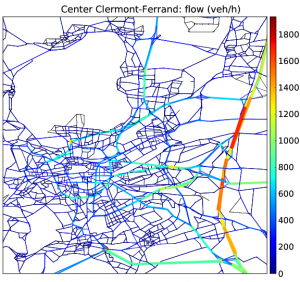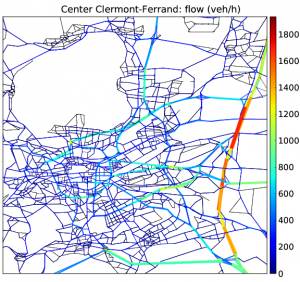Objective
Computing the traffic flow is subject to large uncertainties because of the inaccurate inputs (especially in the origin/destination matrix) and shortcomings in the traffic modeling. Our objective is to quantify these uncertainties. One major difficulty lies in the high computational cost of the DTA model, which prevents the application of classical methods for uncertainty quantification. Therefore, we designed a meta-model for the dynamic traffic assignment model LADTA.
Meta-modeling based on dimension reduction and statistical emulation
We built a meta-model of the dynamic assignment model LADTA using a first step of dimension reduction, and a second step of statistical emulation. We applied the approach to the case of the metropolitan area of Clermont-Ferrand (France). The resulting meta-model shows very similar results to LADTA; See below for the time evolution of the spatially-averaged flow:
The time averages of the flow, as computed below for the center of Clermont-Ferrand (France) with LADTA (left), are reasonably well reproduced by the meta-model (right)
While applying LADTA requires several hours to carry out a one-day simulation of traffic, the meta-model only requires 3 seconds.
The performance of the meta-model with respect to the observations was also studied. It turned out to be essentially as good as the original model LADTA.
Reference
More details will be released with the following paper:
R. Chen, V. Mallet, V. Aguiléra, F. Cohn, D. Poulet, F. Brocheton. Meta-modeling of a Dynamic Traffic Assignment Model at Metropolitan Scale. To be submitted.




